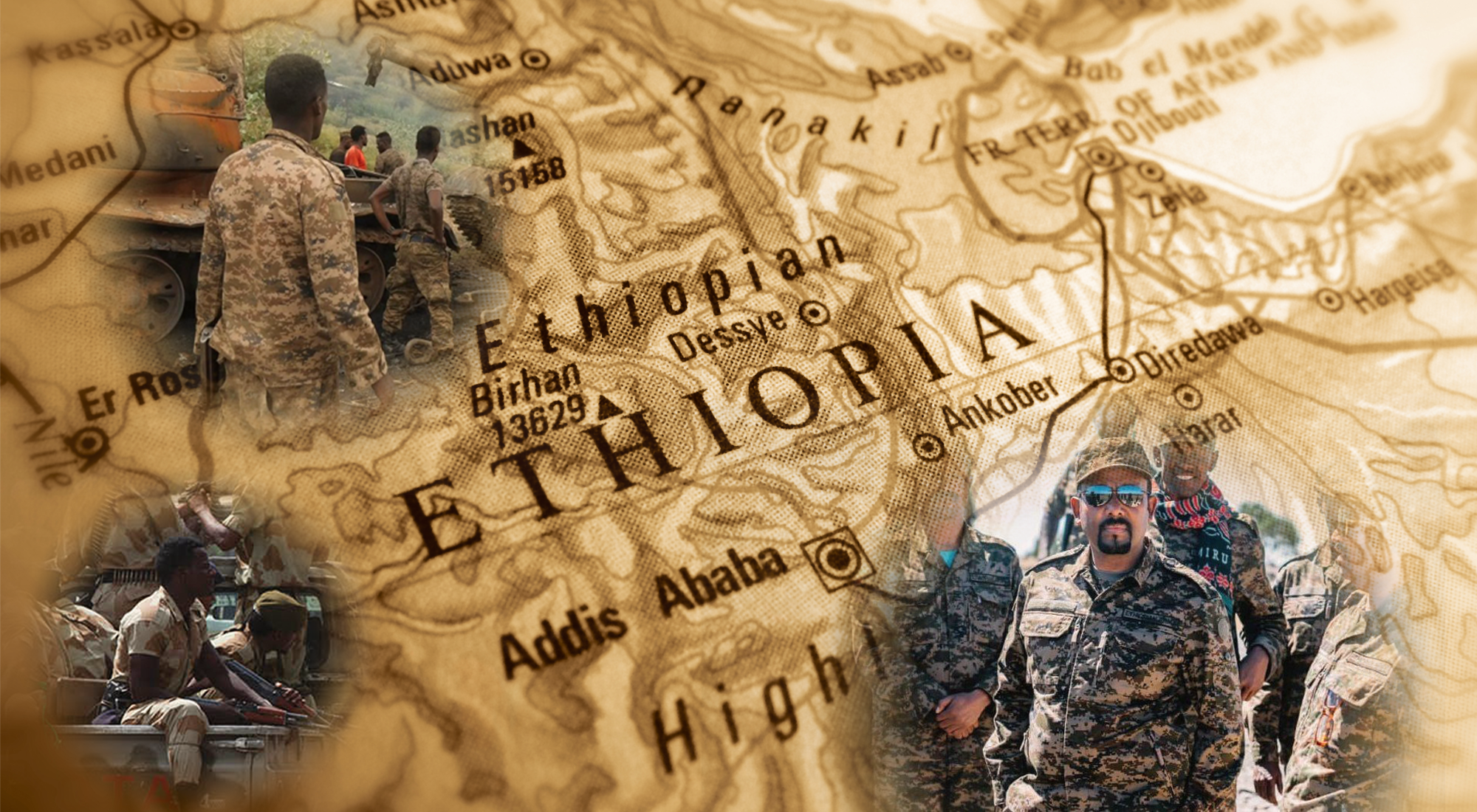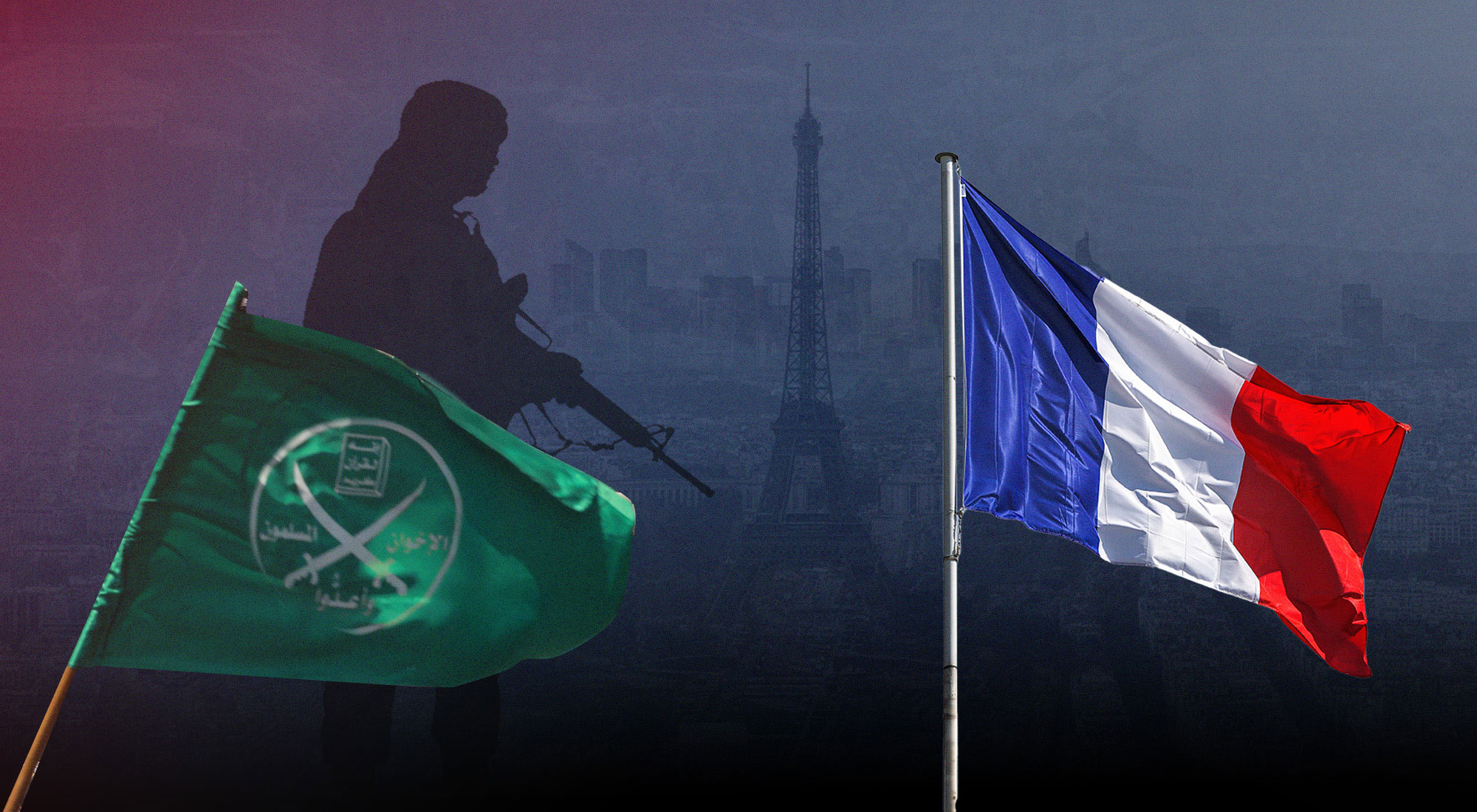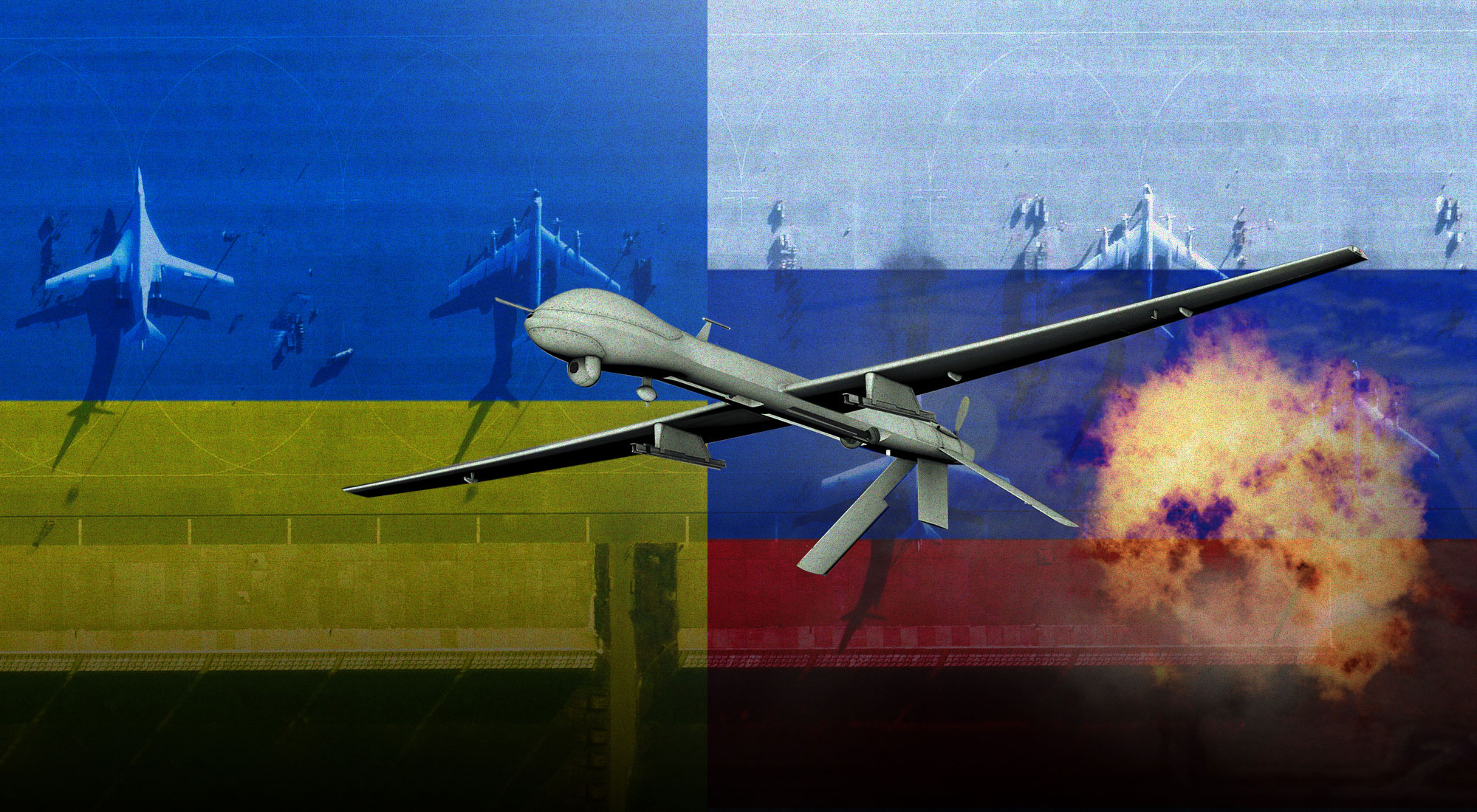Shaped by the Amharas for centuries based on a monarchical system, Ethiopia has been a federal republic since 1995. The leaders of one of the semi-autonomous states, Tigray, in conflict with the government, do not recognise the legitimacy of the Prime Minister Abiy Ahmed, since his initial mandate – which started in 2018 – ought to have ended in October 2020. Legislative elections, which would have decided the next prime minister, were postponed due to the pandemic, hence he was neither re-elected nor replaced. By provoking a massive exodus to Sudan, the Ethiopian Prime Minister’s military operation in the region controlled by the Tigray Peoples’ Liberation Front (TPLF), caused a civil war and a destabilisation of the mosaic of peoples in Africa’s second most populous country of nearly 110 million inhabitants.[1]
Tigray is mainly home to Tigrayans, which constitute 6% of the Ethiopian population – including 30 million Oromo and as many Amharas. The conflict between Addis Ababa and this breakaway region in northern Ethiopia, which has reportedly left more than 10,000 people dead since it began in November 2020, illustrates the strong historical opposition among the main ethnic groups and their fight for power. The Amharas, Oromo and Tigrayans since the 17th century have had antagonistic plans for the conquest and administration of territories.[2] The political base of the Amharas, established in the 15th century, is based on the army, the church and the kingdom. The Tigrayans’ political system is essentially communal and the Oromo system has some similarities with the Western democratic system. Oromo and Tigrayans were long “marginalised” by Amhara culture before the TPLF took control of a coalition in Addis Ababa in the 1990s. Abiy Ahmed, who is Oromo and has been in power since 2018, has been accused by Tigrayans of having totally excluded them from the leadership of the country.
In order to build an efficient analysis, what follows adopts the historical approach which builds “a continuity… framework for the phenomena.”[3]
- The ‘biblical’ project carried by the Amharas
The distribution of populations and the political conflicting relationships around territorial division, as seen today in this country with some 110 million inhabitants, date back to the 17th century. They are the result of major regional wars in the sixteenth century; religious wars between the Muslim States in the east of present-day Ethiopia and the Christian kingdom. Behind the “ethnicities” were different political projects, with a monarchical pole centred on a dynasty that embodied a centrality of power, a legitimacy of power by divine right. The biblical project carried by the Amharas, which dates back to the Ethiopian Middle Ages, links the country to biblical history. Christian Ethiopia – the north-western part of present-day Ethiopia – conceived itself as a form of restoration of the monarchy of Israel, adopting its model of justice in the resolution of territorial disputes. Ethiopia’s political constitutionality was biblical until the Emperor of Ethiopia, Haile Selassie, in the twentieth century, amended the constitution to proclaim that Ethiopia was a descendant of Israel, and that the “king of kings” was a descendant of the Queen of Sheba and King Solomon.[4]
If the thought of a coordinated political unity, around a strong normative centre, persists through Amhara ethnicity, it is because of enduring efforts to absorb peripheral populations through the army and the church, through the process of evangelisation. A kind of expansionist device aimed at extending the kingdom’s tributary populations, integrating them first in a servile status, as slaves, as dominated populations, and then incorporating them little by little into a normative Amhara (“gentleman”) model, whereby they are immersed in language and culture.[5] Through the conquest of territories and peoples in the form of crusades, the Amhara tried to build a Christian kingdom in the Horn of Africa by imposing their beliefs on other communities and enslaving them.
 Source: TRT WORLD
Source: TRT WORLD
- The orthodoxy of the Tigrayan and Oromo political projects
The Tigrayans are Orthodox Christians living in the north of the country, with a language similar to that of the Amharas. These two populations, which are now fighting over ancient territorial disputes, have much in common. They share the same religion and consider themselves as part of the Abyssinian culture.
Regarding themselves as the legitimate heirs of the ancient Aksum Empire, the Tigrayans evolved politically in the eighteenth century towards an association with the Amhara kingdom, located to the south of their territory. By remaining in the north, in their historical stronghold, the Tigrayans accepted this form of coexistence, but on condition that the Amhara allowed them a degree of autonomy in their extremely communitarian political model with local powers. Tigray, which is referred to as a general entity, is in reality a very fragmented region with territories, about ten in number, which have strong clan-based political identities. Each of these territories has its own customary law, community traditions, cultural ways of settling disputes, and democratic decision-making mechanisms. They are located around Aksum, the “sacred heart” where, according to Ethiopian Christians, the “Ark of the Covenant” was deposited. The Tigrayans consider themselves the “guardians of the temple”.
The Oromo were originally settled in the highlands of south-eastern Ethiopia. It was in the context of the weakening of the Christian and Muslim kingdoms, following the religious wars of the 16th century that they occupied the vacant space, proposing an alternative political project.[6]
This complex political project is totally different from the Christian hierarchical, dynastic and monarchical project. The Oromo have a system of generational rotation in social and political activities that has spread throughout the territories, which make up what is now Oromia. The Oromo political model can be considered democratic, since it offers a form of participation in the activities of power, a form of organising mandates with agreed terms of office, with grand rituals every eight years for the transfer of office from one group to another. Over the centuries, populations have been collectively and progressively integrated into the Oromo political culture, to the point of merging with it.
- The jeopardy of Tigrayan and Oromo cultures in the 20th century
The foundation of contemporary Ethiopia was laid at the end of the 19th century. During his reign, Emperor Menelik II re-established the authority, and the ancient and lost unity of the kingdom, by reconquering the territories lost by the Crown, “colonising” the population and integrating the Oromo by force. He completed the Christian expansion into the southern territories and obtained the validation of his sovereignty, as well as that of Ethiopia’s borders, by all the international powers. This unifying imperial monarchical model is constitutive of the Ethiopian State as it is today. Throughout the 20th century, there was a disregard for local cultures, particularly the demographically huge Oromo culture and also the Tigrayan culture, which was marginalised, side-lined and unable to benefit from foreign investment concentrated in the capital Addis Ababa. Tigray was also occupied by military and religious dignitaries appointed by Addis Ababa, and was left out of the development policy. The political cultures of the Oromo and Tigrayans were then seen as archaic folk traditions. Political modernity came through Ethiopian culture expressed in the Amharic language.
Together with the TPLF, the Tigrayans were in power in Addis Ababa when Ethiopia was divided into a patchwork of administrative regions in the 1990s, forming a federation organised along ethnic lines.[7]
- The legitimacy of the central government questioned by the Tigrayans
Bordered to the west by Sudan and to the north by Eritrea, Tigray is one of the ten semi-autonomous states that have formed the Ethiopian federation, organised along ethnic lines, since the 1990s. The TPLF, having played a major role in bringing down the military-Marxist regime of dictator Mengistu Haile Mariam in 1991, dominated the ruling coalition at the time. This was a coalition of ethno-regional parties, which he ruled until Abiy Ahmed became prime minister in 2018. Tigrayans, because of their predominant position in the Ethiopian army, were also in the front line of the 1998-2000 war against Eritrea, which officially ended with Abiy Ahmed’s peace initiative.[8]
The Nobel Peace Prize laureate is being challenged by the TPLF for having “merged” the former ruling coalition into a single party, the “Prosperity Party”, and for having progressively pushed Tigrayans out of the country’s leadership, in a context of resurgent ethnic tensions and clashes between young Amhara and Tigrayan militiamen in particular. Also, if Amharas are fighting alongside federal troops today, it is due to a historical opposition. They are attacking the Tigrayan enemy. The Amharas want to avenge their loss of power when the TPLF ruled the country from 1991 to 2018, even though the country is currently ruled by an Oromo. This rivalry between Amharas and Tigrayans goes back centuries.[9] In September 2020, Tigray held its own elections, defying the government, which had postponed all polls due to the Covid-19 pandemic.
The Tigray government, which has since been declared illegal by the Ethiopian parliament, has shown its determination to fiercely oppose the Prime Minister, who is regularly accused of being a “relentless centraliser” to the detriment of the regions.
- Manipulation along ethnic lines by political entrepreneurs
Abiy Ahmed is confronted with the mistrust of the entire population and is challenged in particular by part of the Oromo youth. He has even been described as authoritarian by his detractors because of his centralism. The crisis of the Ethiopian ethno-federal system has resulted in an increase in inter-community conflicts whose goal is to have absolute control over political power. This has been the case over the past two years, particularly in five regions (Amhara, Oromia, Benishangul-Gumuz, Harar and SNNPR (Southern Nations, Nationalities and People’s Regional State), according to Amnesty International. In a report published on 29 May 2020, by the newspaper Le Monde, the NGO accuses the Ethiopian army and regional security forces of having participated, on several occasions, in atrocities in Amhara and Oromia, the most populous regions of the country.[10]
Tigray is heavily militarised and is home to the headquarters of the Northern Command, which is said to have about 40% of the federal troops. While the balance of power may appear unbalanced vis-à-vis Addis Ababa in the current conflict, journalist and Horn of Africa specialist Tristan Coloma asserts that the Tigrayans have the means not only to defend themselves but also to conquer other territories. The Tigrayan army is more powerful than the Ethiopian national army and it benefits from the rallying of soldiers or officers from the garrisons on the borders with Eritrea. This is not a purely ethnic civil war, and if there are abuses, ethnicity is above all used for political purposes. By destabilising Abiy Ahmed, through movements of Oromo and Amara nationalists and opponents, and by financing them, the Tigrayans want to implode Ethiopia. They also want to overthrow Isaias Afwerki, the Eritrean president, to take power in the neighbouring country and set up a “Greater Tigray” with access to the sea. And by forming an alliance with some of the Afars of Ethiopia, they also seek to cut off the sea access route to Addis Ababa via Djibouti.
The Anthropologist and historian Éloi Ficquet believes that the aim of the Tigrayans is not to secede or declare their independence.[11] While the Tigrayans historically see themselves as custodians of the temple around Aksum, the “sacred heart”, the TPLF today, in the same way, sees itself as custodian of the temple of the Federal Constitution promulgated in 1995. For the latter, the preferred option of the Tigrayans was to maintain themselves in an Ethiopia rebuilt around its diversity, by abandoning their role as coordinator of the central power and by withdrawing into their historical territory. “They were simply asking to be left alone, as compensation for leaving Addis Ababa, smoothly in 2018, after they had accepted that there would be a transition, that it would be the Oromo’s turn to take charge of the common destiny.”[12]
Abiy Ahmed has been in power since 2018, without having been elected. Appointed on the basis of internal arbitration in the coalition that he later dissolved, the Prime Minister, a Pentecostal Christian, is known for his religious preaching. By posing as a charismatic leader, he keeps postponing the polls that Tigrayans believe are necessary to confirm or not his legitimacy, as well as theirs, before their people. When he came to power, Abiy Ahmed allowed the release of political opponents, the return of opposition movements in exile, and promised to organise the first free and transparent elections in Ethiopia’s history. But the status quo has been preserved since his arrival in power. Despite some signs of change, it is a totalitarian system that rules the country.
Conclusion
This is an ethno-regional conflict. It is understandable that in this context of socio-political plurality, where animosity has reached a point of no return and has not been transcended and transformed, a policy of participatory dosing in the management of public affairs is essential to avoid the exclusion of groups and regions in the overall development process of the nation. Here, the democratic alternation that was made possible has unfortunately been undermined by the fear of strategic groups – demographically in the minority – losing power democratically forever and the frustration of conflicting groups – demographically in the majority – of always having to remain on the periphery of power. An immutable, even prophetic truth specific to a community weakens the balances that should exist in this cosmopolitan, heterogeneous and multicultural whole.
An understanding of the concepts of ‘strategic group’ and ‘conflict group’ would open a way to an outline of a solution. A group is said to be strategic when its members have control over the bulk of the administrative and institutional powers of the state.[13] It controls the security apparatus of the state and the institutional mechanisms for redistributing resources at all levels. It exercises a monopoly on the state’s sovereign power and controls all sources of public revenue. Conflicting groups are groups that have a real potential to threaten political destabilisation and are on the periphery of power.[14] They are kept at a distance from the state apparatus and therefore harbour a sense of political frustration.
In Ethiopia, we find that groups show an emotional attachment to specific geographical markers. The rotation of power at the head of the state must be effective in order to give all groups the opportunity to assume the supreme magistracy through democratic elections where all the people express their vote. This would prevent any conquest of power.
References
[1] “Ethiopia Population,” World Population Review, https://worldpopulationreview.com/countries/ethiopia-population.
[2] Bahru Zewde, A History of Modern Ethiopia, 1855–1991 (Athens: Ohio University Press, 2001).
[3] Madeleine Grawitz, Méthodes des sciences sociales (Paris: Dalloz, 2001).
[4] Edmond Keller, Revolutionary Ethiopia From Empire to People’s Republic (Bloomington: Indiana University Press, 1991).
[5] Ibid.
[6] Éloi Ficquet, « Éthiopie : du conflit régional à la guerre,» France Culture, November 2021, https://www.franceculture.fr/emissions/cultures-monde/ethiopie-du-conflit-regional-a-la-guerre-totale.
[7] Arnaldo Mauri, “Monetary Developments and Decolonization in Ethiopia,” Acta Universitatis Danubius Œconomica 6, No. 1 (2010).
[8] Ibid.
[9] Éloi Ficquet, « Éthiopie : du conflit régional à la guerre,» France Culture, November 2021, https://www.franceculture.fr/emissions/cultures-monde/ethiopie-du-conflit-regional-a-la-guerre-totale.
[10] Mariama Darame, « L’Ethiopie d’Abiy Ahmed n’est pas en paix, » Le Monde, June 1, 2020, https://www.lemonde.fr/afrique/article/2020/06/01/l-ethiopie-d-abiy-ahmed-n-est-pas-en-paix_6041422_3212.html.
[11] Gérard Prunier and Éloi Ficquet, Understanding Contemporary Ethiopia: Monarchy, Revolution and the Legacy of Meles Zenawi (London: Hurst & Co. Publishers, 2015).
[12] Éloi Ficquet, « Éthiopie : du conflit régional à la guerre, » France Culture, November 2021, https://www.franceculture.fr/emissions/cultures-monde/ethiopie-du-conflit-regional-a-la-guerre-totale.
[13] Célestin Tagou, Démocratie rotative (Presse des Universités Protestantes d’Afrique & Les Editions du Schabel, 2017).
[14] Ibid.








